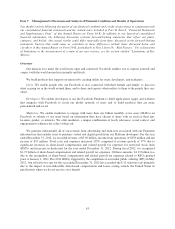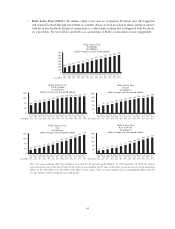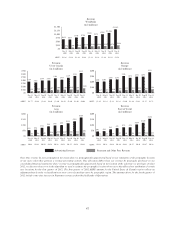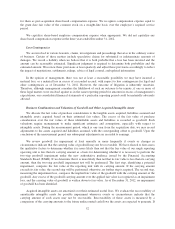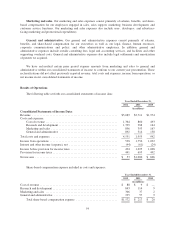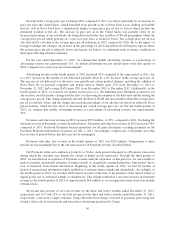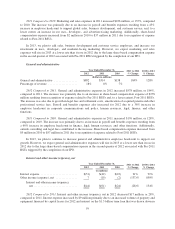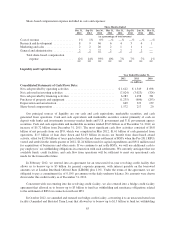Facebook 2012 Annual Report Download - page 57
Download and view the complete annual report
Please find page 57 of the 2012 Facebook annual report below. You can navigate through the pages in the report by either clicking on the pages listed below, or by using the keyword search tool below to find specific information within the annual report.such review indicates that the carrying amount of property and equipment and intangible assets is not
recoverable, the carrying amount of such assets is reduced to fair value. We have not recorded any such
impairment charge during the years presented.
In addition to the recoverability assessment, we routinely review the remaining estimated useful lives of our
amortizable intangible assets. If we reduce the estimated useful life assumption for any asset, the remaining
unamortized balance would be amortized over the revised estimated useful life.
Components of Results of Operations
Revenue
We generate substantially all of our revenue from advertising and from fees associated with our Payments
infrastructure that enables users to purchase virtual and digital goods from our Platform developers.
Advertising. Our advertising revenue is generated by displaying ad products on the Facebook website or
mobile app and third-party affiliated websites or mobile apps. Marketers pay for ad products either directly or
through their relationships with advertising agencies, based on the number of impressions delivered or the
number of clicks made by our users. We recognize revenue from the delivery of click-based ads in the period in
which a user clicks on the content. We recognize revenue from the display of impression-based ads in the
contracted period in which the impressions are delivered. Impressions are considered delivered when an ad is
displayed to users. The number of ads we show is subject to methodological changes as we continue to evolve
our ads business and the structure of our ads products. Whether we count the initial display only or every display
of an ad as an impression is dependent on where the ad is displayed. For example, an individual ad in News Feed
that is purchased on an impression basis may be displayed to users more than once during a day; however, only
the initial display of the ad is considered an impression, regardless of how many times the ad is actually
displayed within the News Feed.
Payments and other fees. We enable Payments from our users to our Platform developers. Our users can
transact and make payments on the Facebook Platform by using credit cards, PayPal or other payment methods
available on our website. We receive a fee from our Platform developers when users make purchases from our
Platform developers using our Payments infrastructure. We recognize revenue net of amounts remitted to our
Platform developers. We have mandated the use of our Payments infrastructure for game apps on Facebook, and
fees related to Payments are generated almost exclusively from games. Cumulatively to date, games from Zynga
have generated the majority of our payments and other fees revenue. However, Zynga’s contribution to our
payments and other fees revenue has decreased over time and this trend may continue. Our other fees revenue
consists primarily of user Promoted Posts and, to a lesser extent, Facebook Gifts revenue, and has been
immaterial in recent periods.
Cost of Revenue and Operating Expenses
Cost of revenue. Our cost of revenue consists primarily of expenses associated with the delivery and
distribution of our products. These include expenses related to the operation of our data centers such as facility
and server equipment depreciation, facility and server equipment rent expense, energy and bandwidth costs,
support and maintenance costs, and salaries, benefits, and share-based compensation for employees on our
operations teams. Cost of revenue also includes credit card and other transaction fees related to processing
customer transactions.
Research and development. Research and development expenses consist primarily of salaries, benefits,
and share-based compensation for employees on our engineering and technical teams who are responsible for
building new products as well as improving existing products. We expense all of our research and development
costs as they are incurred.
53


